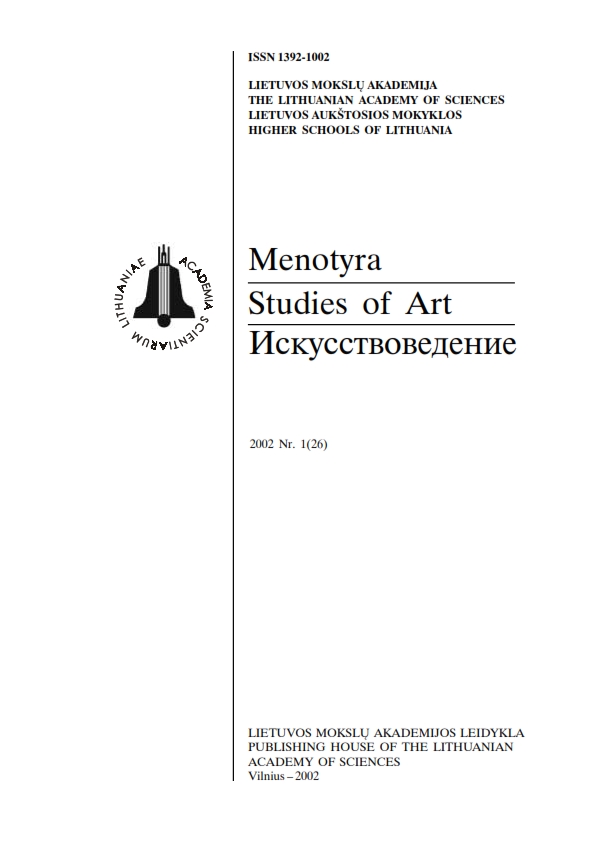Kultūrinė atmintis ir jos muzikinė reprezentacija Onutės Narbutaitės oratorijoje ,,Centones meae urbi"
Onutė Narbutaitė's oratorio "Centones meae urbi": cultural memory and its musical representation
Author(s): Audronė ŽiūraitytėSubject(s): Music
Published by: Lietuvos mokslų akademijos leidykla
Summary/Abstract: With the tendency of globalisation becoming ever more vivid, it inevitably brings to revealing its controversial nature. On the one hand, it results in the danger of levelling cultural distinctions, on the other hand, in the danger of their extinction and the consequent growth of interest in multicultural phenomena. The processes of its strengthening in post-modernistic creation getting more common, and at the same time problematic, they are often closely related to issues of stylistic authenticity. Onutė Narbutaitė in her oratorio "Centones meae urbi" ("Patch-work to My Native City") brings to life cultural memory and reveals its diversity, based on the integrity of musical expression, preserving an unchanged original creative style. The Oratorio "Centones Meae Urbi" for two soloists, chorus and orchestra earned the composer the title of Lithuanian National Laureate in 1997.Centones is a Latin word standing for a piece of writing, composed of borrowed verses and phrases; an antique literary, in later epochs also a musical, game. The literary part of the Oratorio comprises a value in itself. It is absolutely extraordinary and as if giving testimony to the author's marvellous power of imagination and a deep sensation of the city spirit. Lyrics of the Oratorio contain the excerpts from Czesław Miłosz poems, laments from The Old Testament, the 16th century epitaphs by the Jesuit Academy students and professors as well as rhymes by Adomas Mickevičius, fragments from Moshe Kulbak's "Vilne" poem, also a number of quotations from the works by the contemporary Lithuanian poets Eugenijus Ališanka, Vaidotas Daunys, the tomb inscriptions from the Bernardinai and Rasos cemeteries, fragments of the publications from the early 20th century Vilnius press. The words, performed in Lithuanian, Polish, Latin, Yiddish and other languages, extend the borders of the capital of Lithuania as a spiritual centre and remind us that Vilnius was, and continues to be, a European city.In this work cultural memory is represented in its synthetic form. As the word becomes music, music becomes the word; together they create the unique atmosphere of Vilnius stretching through time - where the past and the present become a uniform space, the result of which could be ascribed to the usage of the polystislistic elements. The range of polystylistic associations taking us back to the Middle Ages in a form of the Gregorian-like chorale emanates the air of Baroque and Classicism tradition, as well as bears a strong hint of Romanticism and salon music. Intertextuality as an aesthetic reflection in the Oratorio rises to a semiotic level, because she operates styles in a form of a given value structure, or containing a mark. The inter-textual vocabulary penetrating the text plays here an important role while developing the semantic and communicative processes. The very term "polystilistics" when talking of the Oratorio is somewhat questionable. Despite its all monumentality and diversity, "Centones meae urbi" is authentic (monostilistic) and comes from much the same wellsprings as the rest of Narbutaitė's creations.The emergence of global identity gives an impact to the opposite processes - a strive for isolation. The interaction of these two extremes results in a perfect gateway- a harmonious accord of different cultures which Vilnius has been famous for in the course of ages. Narbutaitė reminds us of it with the utmost suggestiveness, where past is being reborn in the present day.The oratorio "Centones meae urbi" testifies to the author's rich imagination and subtle sense of the spirit of Vilnius, expanding the very concept of the capital of Lithuania up to the limits of its cultural traditions. The oratorio is a "patchwork" mended out of the symbolic figures and "lost voices" representing the diversity of Lithuania's multicultural traditions. The analysis of the composition will focus on contrasting ideas of intertextuality and authenticity in Narbutaitė's music.Different spaces of the oratorio performance and its diverse interpretation brings out the significance of this multisphere and conceptual work, each time revealing new aspects of its multicultural content and the inexhaustible strati of the Vilnius mystery.
Journal: Menotyra
- Issue Year: 2002
- Issue No: 1(26)
- Page Range: 25-34
- Page Count: 10
- Language: Lithuanian

